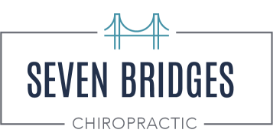Did you know?
- Low back pain is one of the most common reasons people seek chiropractic care. (1)
- Worldwide, back pain is the single leading cause of disability, preventing many people from engaging in work as well as other everyday activities.(2)
- Back pain accounts for more than 264 million lost work days in one year—that’s two work days for every full-time worker in the country. (3)
However, pinpointing the exact source of the pain can be tricky because multiple structures in the lower back can contribute to discomfort.
One condition we see frequently at Seven Bridges Chiropractic is lumbar facet syndrome—a source of localized or radiating low back pain that often starts after a simple movement, like standing up too quickly or bending over to pick something up.
Let’s dive into what lumbar facet syndrome is, what causes it, and how chiropractic care can help.
Lumbar Facet Joints
Your spine is made up of 24 vertebrae, and between them are joints that allow movement and flexibility. In the lower back, each segment has three joints:
- The intervertebral disc (which acts as a cushion).
- Two facet joints, which guide movement.
Facet joints are relatively small, but they play a big role in how your spines ability to move. They allow for bending forward and backward while limiting excessive twisting. When these joints become irritated, inflamed, or compressed, they can cause significant pain and discomfort—this is what we call lumbar facet syndrome.
Causes of Lumbar Facet Syndrome
Facet syndrome occurs when one of the facet joints isn’t functioning properly and causes the small nerves that supply the facet joint becomes irritated. This can happen due to:
- Degeneration – As we age or experience repetitive strain (what we call micro-traumas), the cartilage inside the facet joints can wear down. This can lead to inflammation and joint irritation, making movement painful.
- Osteophytes (Bone Spurs)- The body sometimes responds to joint stress by growing extra bone (osteophytes) around the joints. These bony growths can alter the joint ability to move and can even pinch nearby nerves, contributing to pain.
- Trapped Meniscoids- Inside facet joints are small, fibrous structures called meniscoids, which help with joint movement. Occasionally, these can get pinched between the bones, causing sharp pain and discomfort.
Symptoms of Lumbar Facet Syndrome
Clinical facet joint syndrome is defined as a unilateral or bilateral back pain radiating to one or both buttocks, sides of the groin, and thighs, and stopping above the knee (4). But the majority of the time facet-related pain is usually localized to one side of the lower back and often starts after a minor movement, like twisting or standing up too quickly. Some common symptoms include:
- Achy or sharp pain on one side of the lower back.
- Discomfort that may radiate to the hip, buttock, or thigh (but usually not past the knee).
- Increased pain when arching backward or standing for long periods.
Unlike a herniated disc, facet syndrome typically does not cause numbness, tingling, or weakness in the lower section of the leg(s).
How We Diagnose Lumbar Facet Syndrome
At Seven Bridges Chiropractic, we take a thorough approach to diagnosing facet syndrome. This includes:
- Deep dive into you pain history: Understanding when and how your pain started.
- Physical exam & Orthopedic testing: Looking at your range of motion and movements like Kemp’s Test (a gentle spinal rotation and extension) can help pinpoint facet-related pain.
- Rule out other conditions: We ensure the pain isn’t coming from a disc herniation or nerve root irritation through the thorough examination process.
If facet syndrome is the likely cause, we develop a personalized treatment plan to help you move and feel better.
Chiropractic Treatment for Lumbar Facet Syndrome
Chiropractic adjustments are highly effective for facet-related pain because they help restore proper movement to the joints and reduce nerve irritation. Studies even show that adjustments create space in the facet joints, which can relieve pressure and inflammation.
At Seven Bridges Chiropractic, our approach includes:
- Muscle release, stretching & Mobility Work – Addressing tight paraspinal muscles to improve flexibility.
- Spinal Adjustments – Gentle, targeted adjustments to improve mobility and relieve pressure on the facet joints.
- Prescriptive Exercises – Strengthening the core and lower back to improve stability and prevent future irritation.
- Lifestyle Modifications – Helping you identify and adjust daily habits that may be contributing to flare-ups.
Take the Next Step Toward Pain Relief
If you’re experiencing persistent low back pain, you don’t have to just live with it. A Jacksonville Chiropractor can provide relief by restoring movement, reducing inflammation, and helping you stay active without pain.
At Seven Bridges Chiropractic, we focus on one-on-one, individualized care to get you back to doing what you love—whether that’s working out, playing with your kids, or just getting through the day comfortably.
Ready to feel better? Book an appointment today at sevenbridgeschiro.janeapp.com or call (904)582-5200, and let’s get you moving pain-free again.
Sources
(1) Liste, S. (2023, June 19). Low back pain. World Health Organization. https://www.who.int/news-room/fact-sheets/detail/low-back-pain#:~:text=In%202020%2C%20low%20back%20pain,prevalent%20in%20women%20
(2) Alexander, C. E. (2023, August 4). Lumbosacral facet syndrome. StatPearls [Internet]. https://www.ncbi.nlm.nih.gov/books/NBK441906/
(3) USBJI announces New Publication: The hidden impact of musculoskeletal disorders on Americans. American Medical Women’s Association. (2018, June 28). https://www.amwa-doc.org/news/usbji-announces-new-publication/
(4) Manchikanti L, Singh V, Pampati V et al (2001) Evaluation of the relative contributions of various structures in chronic low back pain. Pain Physician 4(4):308–316
